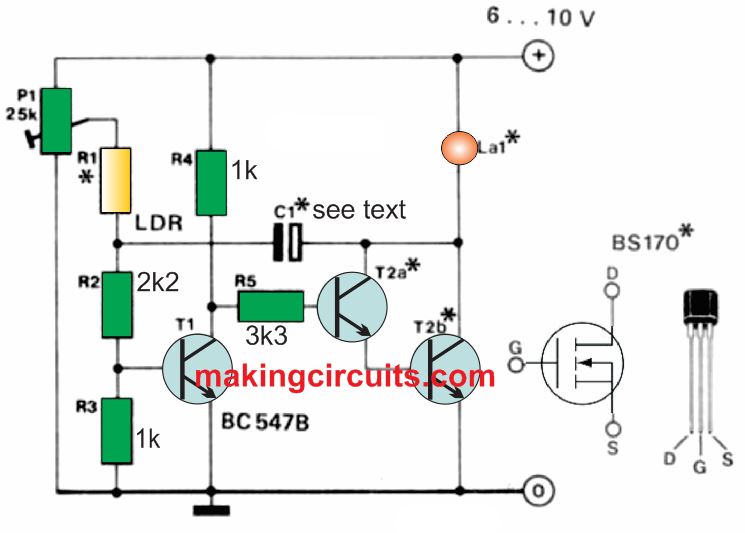This simple flashing LED light will begin flashing as soon as darkness sets in, and will shut off in the morning when day light arrives back.
The operation of the LDR switch is to automatically turn the flashing lights on when its dark and off again with there is natural light availble. This feature makes it ideal for its use as as a warning light when facing obstructions.
One more use of this flashing twilight switch would be in the field of education to signify the operation of transistors in conjunction with opto-electronics.
How the Circuit Works
The transistor conducts sufficient base current through T1 as the LDR (Light Dependent Resistor) has a low resistance value during daytime. The L1 Lamp then stays off as the collector voltage is small and the n-p-n darlington, T2 is off as well.

With the ambient light intensity decreases significantly, there is an increase in the resistance of the LDR.
The collector voltage then increases as the base current in T1 becomes insufficient and it switches off which in turn makes T2 conduct electricity and you find Lamp L1 is illuminated.
The fall in the collector voltage of T2 to nearly 0V makes the potential immediately applicable to the base T1 using capacitor C1 which helps cut off T1. The LDR is then illuminated by the lighted lamp L1 as the capacitor is charged via P1.
The LDR diminishes in accordance to the optical feedback which makes the voltage across R2 increase which in turn makes T1 conduct again. A new cycle is started as the darlington is switched off and the lamp goes out.
The value of C1 (47uF) is responsible for regulating the flashing frequency This low value increases the frequency by reducing the capacitance.
LED lamp Specification
The other alternatives to the BC 517 darlington are Two numbers of BC 547B transistors or a small signal MOSFET. The observational point is the current through lamp L1. Maximum permissible current through the lamp through 2 nos of BC 547Bs is 100mA, BC 517 is 400mA and with a suitable MOSFET it is 500mA.
When the lamp L1 is off, the current consumption by the circuit is about 8mA at 6V and 10mA at 10V.
A commonly available type of LDR is used, namely, LDR 03, 05, 07.
For best results, the LDR must be fitted near lamp L1. Onset of operation is set with P1.
Leave a Reply